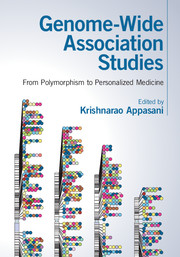Book contents
- Frontmatter
- Dedication
- Contents
- List of contributors
- Forewords
- Preface
- List of abbreviations
- Part I Genome-wide association studies
- 1 Introduction to genome-wide association studies and personalized medicine
- 2 GWAS: a milestone in the road from genotypes to phenotypes
- 3 Introduction to statistical methods in genome-wide association studies
- 4 GWAS replicability across time and space
- Part II Genome-wide studies in disease biology
- Part III Single nucleotide polymorphisms, copy number variants, haplotypes and eQTLs
- Part IV Next-generation sequencing technology and pharmaco-genomics
- Part V Population genetics and personalized medicine
- Index
- Plate section
- References
1 - Introduction to genome-wide association studies and personalized medicine
from Part I - Genome-wide association studies
Published online by Cambridge University Press: 18 December 2015
- Frontmatter
- Dedication
- Contents
- List of contributors
- Forewords
- Preface
- List of abbreviations
- Part I Genome-wide association studies
- 1 Introduction to genome-wide association studies and personalized medicine
- 2 GWAS: a milestone in the road from genotypes to phenotypes
- 3 Introduction to statistical methods in genome-wide association studies
- 4 GWAS replicability across time and space
- Part II Genome-wide studies in disease biology
- Part III Single nucleotide polymorphisms, copy number variants, haplotypes and eQTLs
- Part IV Next-generation sequencing technology and pharmaco-genomics
- Part V Population genetics and personalized medicine
- Index
- Plate section
- References
Summary
My scientific studies have afforded me great gratification; and I am convinced that it will not be long before the whole world acknowledges the results of my work.
Gregor J. Mendel, Austrian botanist/geneticist (1822–1884)Ronald A. Fisher, an English statistical geneticist, showed for the first time that a complex quantitative trait can be explained by Mendelian inheritance if multiple genes affect the trait (Fisher, 1918). Thus, one can infer accurate statistical predictions of a complex trait requiring the identification of many small-effect variants, which, in combination, can explain a large fraction of variance in the phenotype. Before 1990, a number of examples of pharmaco-genetic traits, usually binary, were published and reviewed (Nebert et al., 2008). Most of them adhere to simple Mendelian inheritance and are controlled by one or a very small number of large-effecter genes. These breakthroughs in genotype–phenotype associations helped to establish expectations of individualized genetic risk prediction. In the pre-genomic era, the genetic dissection of complex diseases was done through classical linkage studies (Lander and Botstein, 1989), and candidate gene-based association studies (Cousin et al., 2003; Patnala et al., 2013). The classical linkage study is a powerful approach to identify rare and high penetrant disease variants or genes, whereas the candidate gene approach was limited to a few genetic markers that are involved in the pathogenesis of complex diseases.
The genome-wide association studies (GWAS) approach was first proposed by Risch and Merikangas in 1996 as a statistical method to detect common variants with modest genetic effects compared to linkage studies. A global collaborative effort called the “HapMap project” was initiated in 2003 to characterize the haplotype patterns in the human genome and subsequently to identify single nucleotide polymorphism (SNPs or snips; The International HapMap Consortium, 2005). HapMap resources guided the design and analysis of genetic association studies that shed light on structural variation and recombination, and identified loci that are involved in natural selection during human evolution. Since the discovery of GWAS and SNPs, association studies have been increasingly employed to reveal the relationships between SNPs and particular disease conditions. The first large set of results from a GWAS were reported in 2005 and 2006 (Klein et al., 2005; Dewan et al., 2006).
- Type
- Chapter
- Information
- Genome-Wide Association StudiesFrom Polymorphism to Personalized Medicine, pp. 3 - 11Publisher: Cambridge University PressPrint publication year: 2016



